Monday, March 30, 2015
1979-80 Quebec Nordiques Ron Chipperfield Jersey
On this date in 1979, the NHL announced the expansion of the league from 17 teams to 21 with the addition of the Edmonton Oilers, Hartford Whalers, Quebec Nordiques and Winnipeg Jets, all of whom played in the World Hockey Association from 1972-73 until 1978-79. Combined, the four clubs won five of the seven Avco World Cup championships, with the defunct Houston Aeros, led by Gordie Howe, having won the other two.
The Jets celebrate winning the final Avco Cup in 1979
When the WHA teams were allowed to enter the NHL, the old WHA teams were permitted to protect only two goaltenders and two skaters, as the NHL teams raided their rosters in the 1979 Expansion Draft, seeking a return of players whose rights they once held.
The WHA teams were also each required to pay a $6 million expansion fee for the privilege of having their team decimated. This was a far different scenario than a "merger" between the leagues, in which case the incoming WHA teams would have been able to keep their rosters intact and not pay an expansion fee.
The Oilers thus stared life in the NHL with a roster consisting of goaltenders Dave Dryden and Eddie Mio, plus skaters Bengt Gustafsson and Wayne Gretzky. Although no NHL team held Gretzky's rights, and under existing rules he would have been removed from the Oilers and placed into the Entry Draft, the Oilers were allowed to keep him with the stipulation of being required to pick dead last in each round of the 1979 NHL Entry Draft of incoming new players, behind even current Stanley Cup champions the Montreal Canadiens.
The WHA teams then selected unprotected players from the current NHL teams to fill out their rosters, but only after the NHL teams were allowed to protect two veteran goalies and seventeen skaters. Think about that for a second. In the best case scenario, a WHA team would get the 20th best player from any NHL team. The results were predictable, as the WHA teams all finished in the bottom eight of the standings. However, a ridiculous 16 of 21 teams made the playoffs back then, so Edmonton and Hartford did manage to qualify for the postseason, with the Oilers being swept in three games by Philadelphia.
Amazingly, within just three years, coach and GM Glen Sather had a team that included Gretzky, but also Mark Messier, Glenn Anderson, Jari Kurri, Paul Coffey, Kevin Lowe plus goaltenders Grant Fuhr and Andy Moog. Easily the most successful to make the transition to the NHL, the Oilers made it to the Stanley Cup Finals for the first time in 1983, losing to the Islanders, before winning the Stanley Cup in 1984, ending the Islanders dynasty and beginning one of their own.
Here is a 1978-79 Edmonton Oilers Garnet "Ace" Bailey jersey from the Oilers final season in the WHA when the home white jerseys had a dreadful combination of blue letters on an orange background while the road blues had orange letters on a white background.
For their first NHL season, the Oilers mercifully changed to a much higher contrast and much more pleasing combination of blue letters against a white background for both their home and road jerseys, which they continue to use to this day.
While Hartford qualified for the playoffs that first NHL season of 1979-80, it would flatter to deceive, as they would miss the playoffs for the next five seasons, including finishing with a league worst 45 points in 1982-83. They would win their only playoff series in 1985-86 with a three game opening round sweep of the Nordiques and follow that with an Adams Division championship thanks to a franchise best 93 points, only to fail in the opening round of the playoffs to Quebec, who finished fourth in the division 21 points behind the Whalers.
Five more consecutive first round exits were followed by five more seasons of failing to qualify for the postseason prior to the franchise relocating to North Carolina, where they would win the Stanley Cup in 2006 as the Hurricanes.
The Whalers not only changed their jerseys for their first NHL season, but were also forced to change their name from the New England Whalers to the Hartford Whalers as the result of a demand by the Boston Bruins, located 102 miles to the northeast.
Here is a WHA-era 1974-75 New England Whalers Tom Webster jersey. Their final WHA jerseys sported a "W" bisected by a harpoon, worn since their second WHA season of 1973-74.
Upon entering the NHL, the Whalers debuted their new "Whale Tail" logo, which obviously featured a "W" for Whalers, but also contained an "H" hidden in the negative space of the logo to represent their change in name to Hartford.
Following their success in the WHA, having won the final two championship titles, the Jets found the transition to the NHL the roughest, as they lost leading scorer Kent Nilsson to the Atlanta Flames, Terry Ruskowski and Rich Preston to the Chicago Black Hawks, Barry Long to the Detroit Red Wings. After having scored 102 points in 1977-78 in the WHA, the Jets plummeted to last in the NHL in 1979-80 with just 51 points. Things got even worse in year 2 with a all-time franchise low of 32 points, which the club turned into first overall selection Dale Hawerchuk.
With the arrival of Hawerchuk, and then Thomas Steen, the club rose to respectability, making the playoffs the next seven seasons, but only winning two playoff rounds over that time. While the club added some remarkable talent in the early 1990's in the shape of Finns Teemu Selanne and Teppo Numminen, Russians Alexi Zhamnov and Nikoali Khabibulin, American Keith Tkachuk, it was not enough to put Winnipeg over the top, as their final eight seasons in Winnipeg saw them miss the playoffs four times and be eliminated immediately the other four prior to their move to Phoenix, Arizona due to economic issues associated with being based in Canada and playing in one of the smallest cities in the league while the Canadian dollar was at a weak point.
This 1977-78 Winnipeg Jets Lyle Moffat jersey illustrates the final style worn in the WHA by the Jets with the white shoulders as well as the lower contrast version of their logo, one with a blue background on a blue jersey, which was immediately changed to a white background for their first season in the NHL for use on their new NHL jerseys, which featured a full length arm stripe from cuff to cuff.
The Jets ushered in their time in the NHL with a completely brand new set of jerseys, adopting a design used by the New York Rangers for a brief period of time when they were under the control of then General Manager John Ferguson, who had taken the same position with the Jets in 1978.
The Jets began life in the WHA with a simple design that featured some unusual contrasting colored and rounded nameplates with an equally odd choice for a font for the names for their first season, but improved their look for 1973-74 by ditching the odd nameplates and font as well as using an improved main crest. This style would remain in use for the rest of their days in the WHA, with the only change being the addition of a white shoulder yoke for the blue jerseys in 1977-78 and 1978-79, as worn while the team captured back-to-back championships to end their days in the WHA.
The Nordiques were unable to qualify for the playoffs during their first NHL season, but quickly became relevant thanks to retaining WHA players Real Cloutier and Marc Tardif and adding in short order Michel Goulet and Peter, Anton and Marian Stastny, who defected from Czechoslovakia at the beginning of the 1980's.
Their intense rivalry with the Montreal Canadiens led to some legendary battles and brawls, particularly in the postseason, as the Nordiques made the playoffs for seven consecutive seasons beginning in 1980-81, including two trips to the conference finals.
After three consecutive seasons of 90+ points, hard times arrived as the team would miss the playoffs six out of seven seasons, including a dreadful period of seasons with 61, 31, 46 and 52 points which allowed the team to select Mats Sundin, Adam Foote, Owen Nolan and Eric Lidros, who was later traded for Peter Forsberg, Mike Ricci, Steve Duchense and Ron Hextall in addition to having already selected future team captain Joe Sakic in 1987.
Unfortunately the same economics of playing in small Canadian city during a low point for the Canadian dollar that plagued Winnipeg also led to the Nordiques relocation, as they were moved to Denver, Colorado, where they would capture their first Stanley Cup in their first season away from Quebec.
Today's featured jersey is a 1979-80 Quebec Nordiques Ron Chipperfield jersey. While the Nordiques were the only one of the four former WHA clubs to keep their same jerseys for their initial NHL season, this was the final season for this variation of the Nordiuqes blue jersey before the Nordiques would change the logo on their road blue jerseys from the white version used in the WHA from 1975-76 to a better looking red version, which matched the one worn on the home whites, leaving the home white Nordiques jersey the only one of the eight possible WHA sweaters to survive the entry into the NHL with any sort of longevity.
Bonus jersey: Today's bonus jersey is a 1980-81 Quebec Nordiques Peter Stastny jersey. The white Nordiques jersey was not only the single jersey to survive the move to the NHL by the four WHA clubs, the Nordqiues were also the final team to use heat sealed numbers on their jerseys before changing over to fully sewn on twill letters and numbers, which they did not adopt until 1991-92, the year they finally added a red outline to their numbers.
This particular jersey shows the wear and tear suffered by the less durable heat sealed material used for the name and numbers on the back. Over time, collectors have had issues with the material peeling off of the jerseys simply due to age, making conservation of these jerseys far more of a challenge than the contemporary jerseys worn by other clubs of the era, which had their names and numbers sewn on.
Today's video in the final minute of the final game in WHA history, as the Jets wrap up their third championship with a win over the Oilers, who would soon win their fare share of championships in the NHL.
Remember the days when fans would come onto the ice after the championship was won? Modern say insurance agents and security personnel all over North America are aghast at the mere thought of it...
Subscribe to:
Post Comments (Atom)

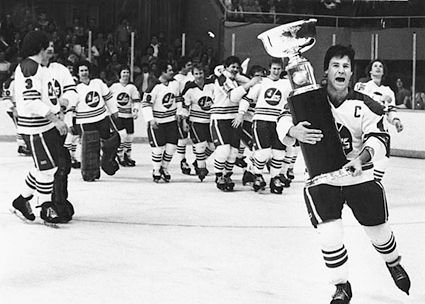

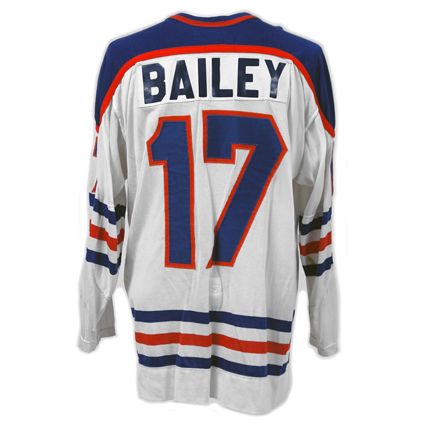
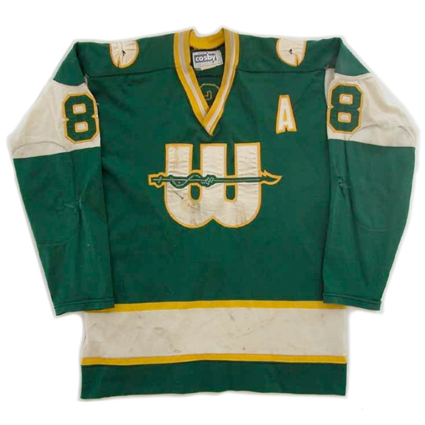
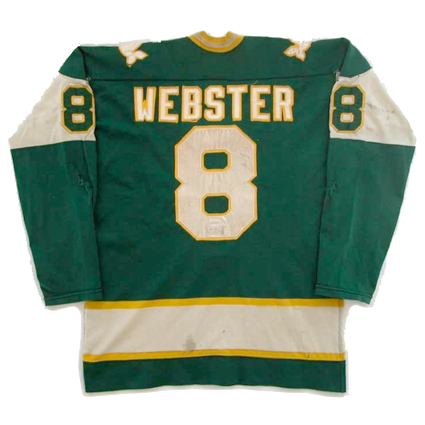
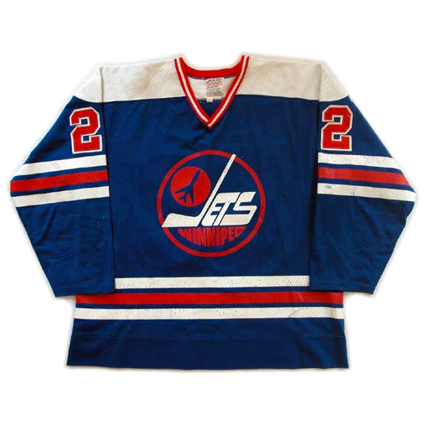
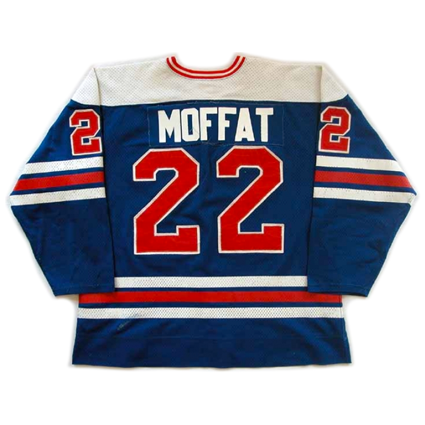
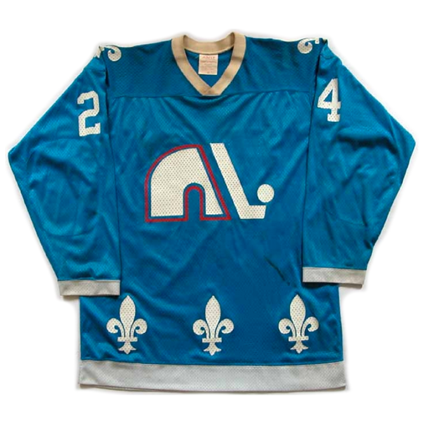
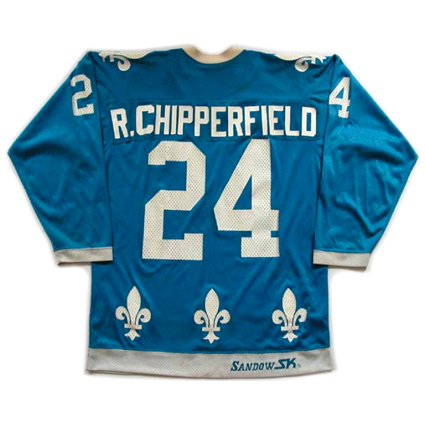
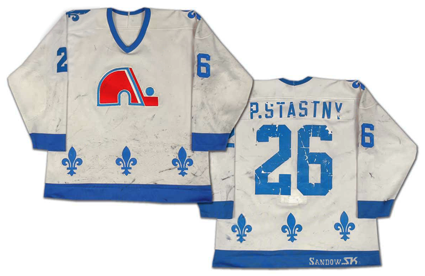










No comments:
Post a Comment
We welcome and encourage genuine comments and corrections from our readers. Please no spam. It will not be approved and never seen.